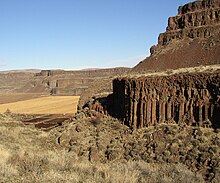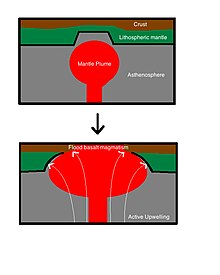Flood basalt

A flood basalt (or plateau basalt
Large igneous provinces have been connected to five
Description


Flood basalts are the most voluminous of all
These vast accumulations of flood basalt constitute
The great thickness of the basalt accumulations, often in excess of 1,000 meters (3,000 ft),[16] usually reflects a very large number of thin flows, varying in thickness from meters to tens of meters, or more rarely to 100 meters (330 ft). There are occasionally very thick individual flows. The world's thickest basalt flow may be the Greenstone flow of the Keweenaw Peninsula of Michigan, US, which is 600 meters (2,000 ft) thick. This flow may have been part of a lava lake the size of Lake Superior.[13]
Deep erosion of flood basalts exposes vast numbers of parallel dikes that fed the eruptions.
Smaller-scale features
Flood basalt commonly displays columnar jointing, formed as the rock cooled and contracted after solidifying from the lava. The rock fractures into columns, typically with five to six sides, parallel to the direction of heat flow out of the rock. This is generally perpendicular to the upper and lower surfaces, but rainwater infiltrating the rock unevenly can produce "cold fingers" of distorted columns. Because heat flow out of the base of the flow is slower than from its upper surface, the columns are more regular and larger in the bottom third of the flow. The greater hydrostatic pressure, due to the weight of overlying rock, also contributes to making the lower columns larger. By analogy with Greek temple architecture, the more regular lower columns are described as the colonnade and the more irregular upper fractures as the entablature of the individual flow. Columns tend to be larger in thicker flows, with columns of the very thick Greenstone flow, mentioned earlier, being around 10 meters (30 ft) thick.[19]
Another common small-scale feature of flood basalts is pipe-stem vesicles. Flood basalt lava cools quite slowly, so that dissolved gases in the lava have time to come out of solution as bubbles (vesicles) that float to the top of the flow. Most of the rest of the flow is massive and free of vesicles. However, the more rapidly cooling lava close to the base of the flow forms a thin chilled margin of glassy rock, and the more rapidly crystallized rock just above the glassy margin contains vesicles trapped as the rock was rapidly crystallizing. These have a distinctive appearance likened to a clay tobacco pipe stem, particularly as the vesicle is usually subsequently filled with calcite or other light-colored minerals that contrast with the surrounding dark basalt.[20]
Petrology
At still smaller scales, the
Flood basalts are most often
Geochemistry

Flood basalts show a considerable degree of chemical uniformity across geologic time,
Though regarded as forming a chemically homogeneous group, flood basalts sometimes show significant chemical diversity even with in a single province. For example, the flood basalts of the
Formation

Theories of the formation of flood basalts must explain how such vast amounts of magma could be generated and erupted as lava in such short intervals of time. They must also explain the similar compositions and tectonic settings of flood basalts erupted across geologic time and the ability of flood basalt lava to travel such great distances from the eruptive fissures before solidifying.
Generation of melt
A tremendous amount of heat is required for so much magma to be generated in so short a time.
The swarms of parallel dikes exposed by deep erosion of flood basalts show that considerable
Flood basalts are often interbedded with sediments, typically red beds. The deposition of sediments begins before the first flood basalt eruptions, so that subsidence and crustal thinning are precursors to flood basalt activity.[11] The surface continues to subside as basalt erupt, so that the older beds are often found below sea level.[17] Basalt strata at depth (dipping reflectors) have been found by reflection seismology along passive continental margins.[31]
Ascent to the surface
The composition of flood basalts may reflect the mechanisms by which the magma reaches the surface. The original melt formed in the upper mantle (the primitive melt) cannot have the composition of quartz tholeiite, the most common and typically least evolved volcanic rock of flood basalts, because quartz tholeiites are too rich in iron relative to magnesium to have formed in equilibrium with typical mantle rock. The primitive melt may have had the composition of
As the magma rises, the drop in pressure also lowers the
Eruption
Once the magma reaches the surface, it flows rapidly across the landscape, literally flooding the local topography. This is possible in part because of the rapid rate of extrusion (over a cubic km per day per km of fissure length[16]) and the relatively low viscosity of basaltic lava. However, the lateral extent of individual flood basalt flows is astonishing even for so fluid a lava in such quantities.[35] It is likely that the lava spreads by a process of inflation in which the lava moves beneath a solid insulating crust, which keeps it hot and mobile.[36] Studies of the Ginkgo flow of the Columbia River Plateau, which is 30 to 70 meters (98 to 230 ft) thick, show that the temperature of the lava dropped by just 20 °C (68 °F) over a distance of 500 kilometers (310 mi). This demonstrates that the lava must have been insulated by a surface crust and that the flow was laminar, reducing heat exchange with the upper crust and base of the flow.[37][38] It has been estimated that the Ginkgo flow advanced 500 km in six days (a rate of advance of about 3.5 km per hour).[37]
The lateral extent of a flood basalt flow is roughly proportional to the cube of the thickness of the flow near its source. Thus, a flow that is double in thickness at its source can travel roughly eight times as far.[13]
Flood basalt flows are predominantly
Eruption in flood basalt provinces is episodic, and each episode has its own chemical signature. There is some tendency for lava within a single eruptive episode to become more silica-rich with time, but there is no consistent trend across episodes.[26]
Large igneous provinces
Large Igneous Provinces (LIPs) were originally defined as voluminous outpourings, predominantly of basalt, over geologically very short durations. This definition did not specify minimum size, duration, petrogenesis, or setting. A new attempt to refine classification focuses on size and setting. LIPs characteristically cover large areas, and the great bulk of the magmatism occurs in less than 1 Ma. Principal LIPs in the ocean basins include Oceanic Volcanic Plateaus (OPs) and Volcanic Passive Continental Margins. Oceanic flood basalts are LIPs distinguished from oceanic plateaus by some investigators because they do not form morphologic plateaus, being neither flat-topped nor elevated more than 200 m above the seafloor. Examples include the Caribbean, Nauru, East Mariana, and Pigafetta provinces. Continental flood basalts (CFBs) or plateau basalts are the continental expressions of large igneous provinces.[40]
Impact
Flood basalts contribute significantly to the growth of continental crust. They are also catastrophic events, which likely contributed to many
Crust formation
The extrusion of flood basalts, averaged over time, is comparable with the rate of extrusion of lava at mid-ocean ridges and much higher than the rate of extrusion by hotspots.[41] However, extrusion at mid-ocean ridges is relatively steady, while extrusion of flood basalts is highly episodic. Flood basalts create new continental crust at a rate of 0.1 to 8 cubic kilometers (0.02 to 2 cu mi) per year, while the eruptions that form oceanic plateaus produce 2 to 20 cubic kilometers (0.5 to 5 cu mi) of crust per year.[16]
Much of the new crust formed during flood basalt episodes takes the form of
Mass extinctions

The eruption of flood basalts has been linked with mass extinctions. For example, the
Some idea of the impact of flood basalts can be given by comparison with historical large eruptions. The
During the eruption of the
However, not all large igneous provinces are connected with extinction events.


List of flood basalts
Representative continental flood basalts and oceanic plateaus, arranged by chronological order, together forming a listing of large igneous provinces:[48]
Elsewhere in the Solar System
Flood basalts are the dominant form of magmatism on the other planets and moons of the Solar System.[61]
The maria on the Moon have been described as flood basalts[62] composed of picritic basalt.[63] Individual eruptive episodes were likely similar in volume to flood basalts of Earth, but were separated by much longer quiescent intervals and were likely produced by different mechanisms.[64]
Extensive flood basalts may be present on Mars.[65]
Uses
Trap rock is the most durable construction aggregate of all rock types, because the interlocking crystals are oriented at random.[15]
See also
- Supervolcano – Volcano that has erupted 1000 cubic km of lava in a single eruption
- Volcanic plateau – Plateau produced by volcanic activity
References
- ISBN 0922152349.
- ^ S2CID 9147772.
- ]
- ^ Neal, C.; Mahoney, J.; Kroenke, L. (1997). "The Ontong Java Plateau" (PDF). Large Igneous Provinces: Continental, Oceanic, and Planetary Flood Volcanism, Geophysical Monograph 100. Archived from the original (PDF) on 2017-01-01.
- PMID 35878029.
- .
- ^ Vincent Courtillot, Paul Renne: On the ages of flood basalt events
- ISBN 9780521880060.
- ^ ISBN 0922152349.
- ^ ISBN 9780199653065.
- ^ a b c d e f Philpotts & Ague 2009, p. 380.
- ISBN 978-3-540-43650-8.
- ^ a b c d Philpotts & Ague 2009, p. 53.
- ^ Schmincke 2003, p. 107.
- ^ a b c d e f g Philpotts & Ague 2009, p. 52.
- ^ a b c d e f Schmincke 2003, p. 108.
- ^ a b c Philpotts & Ague 2009, p. 57.
- ^ Philpotts & Ague 2009, pp. 381–382.
- ^ a b Philpotts & Ague 2009, p. 55.
- ^ Philpotts & Ague 2009, p. 58.
- ^ a b c d Philpotts & Ague 2009, p. 383.
- ^ Philpotts & Ague 2009, p. 366.
- ^ a b Philpotts & Ague 2009, p. 381.
- ^ ISBN 978-0-412-75080-9.
- ^ Philpotts & Ague 2009, p. 367.
- ^ a b c d Philpotts & Ague 2009, p. 382.
- S2CID 4261508.
- .
- .
- .
- ^ a b Schmincke 2003, p. 111.
- ^ Schmincke 2003, pp. 110–111.
- ^ Philpotts & Ague 2009, pp. 57, 380.
- ^ .
- ^ Philpotts & Ague 2009, pp. 52–53.
- .
- ^ .
- ^ Philpotts & Ague 2009, pp. 53–54.
- ISBN 9781118664346. Retrieved 17 January 2022.
- ISBN 9780321592576.
- ^ Schmincke 2003, pp. 107–108.
- .
- ISBN 9780813723969. Retrieved 12 January 2022.
- S2CID 1736350.
- ISBN 9780231180979.
- ^ Philpotts & Ague 2009, p. 384.
- ISBN 9780813725055.
- ISSN 1631-0713. Retrieved 23 October 2021.
- ISSN 0012-821X. Retrieved 23 October 2021.
- ^ a b c Bond & Wignall 2014, p. 17
- .
- Bibcode:2010EGUGA..1213216P.
- .
- S2CID 15895416.)
{{cite journal}}: CS1 maint: numeric names: authors list (link - S2CID 41194645.
- .
- .
- .
- ISBN 978-0-88894-227-2.
- ISBN 978-0-8137-2352-5.
- ISBN 9780123859389.
- ^ Benes, K. (1979). "Flood basalt volcanism on the Moon and Mars". Geologie en Mijnbouw. 58 (2): 209–212.
- .
- S2CID 130489146.
- .
External links
- Flood Volcanism Explained on YouTube
